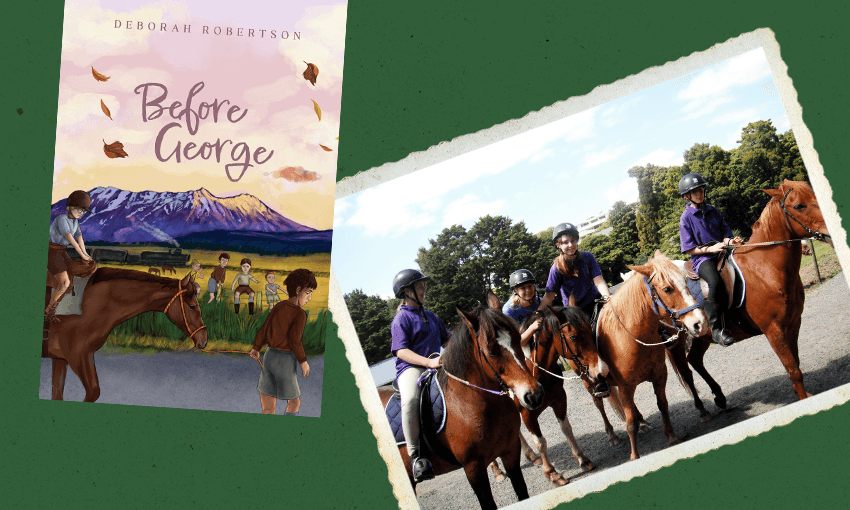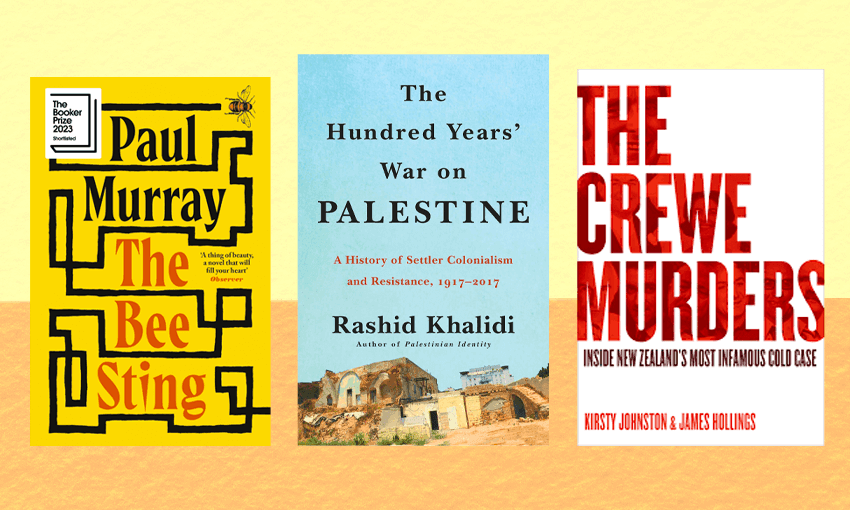Deborah Robertson on what inspired her to write her new novel, and to set it in 1953 – the year of the Tangiwai disaster.
A group of six girls in purple T-shirts are sitting on a log. Well, not really a log. It’s an equestrian hurdle that has been carved out of a log and crudely painted orange so that it looks like a carrot. The youngest girl – 10 years old – has stuffed a bunch of green weeds into the end of it for a laugh. The make-do stalk lasts about 10 minutes before her pony pulls it back out and eats it.
There are as many ponies as girls and they don’t come in uniform – the tack is so mismatched that one horse even has odd stirrups. Someone else has red duct-taped one of the reins.
Is this the picture of the youth of the equestrian world then? Six 10-17 year olds eating their lunch on a hurdle and bickering about who gets the shady spot? Well, no. A few hundred meters away, the actual future of the equestrian world is in tan jodphurs and black leather boots jumping their groomed and plaited ponies around the hurdle course. These girls on the log, scratching sandfly bites and eating biscuits off the grass, are the RDA volunteers.
I was a part of a world that didn’t fit the actual world that I was supposed to be part of – equestrianism is not a poor man’s sport. It’s up there with the likes of sailing and ski holidays. For all that, there’s dozens of girls that like horses and can’t afford a $20,000 horse with a truck to take you to every show in the North Island. So where do you go? Well, in our case you go and volunteer for Riding for the Disabled. You help other kids who have their own set of struggles learn to ride and then on the weekends you take the ponies and tear around the park and surrounding farms until all the pent-up energy is burned off.
As a writer, I’ve always been interested in the concept of the in-between kids. Kids who end up in places where they know they don’t quite fit. You have two options in a place like that; make yourself as small as possible so that hopefully nobody notices you, or own it. Own it good. Your riding gear doesn’t match? Yeah well, at least it’s comfy. You’re wearing Red Band gumboots in stirrups? Yeah well, at least when I have to wade through the creek you won’t catch me complaining about wet feet. I was already a home-schooler, short, buck-toothed and probably knew more about agriculture, horticulture, butchery and survivalism than 90% of kids. I’d shot my own rabbits, eaten them and turned their hides into slippers, read most of the natural history section of the library, and written hundreds of thousands of words saved onto floppy disks. Peer pressure has a different kind of dimension when you’re so far off the bell curve that it’s going to take more than a few standard deviations to get you back into line.
Riding for the Disabled adds another layer of appreciation to this. You’ve got kids with cerebral palsy, muscular dystrophy, Down syndrome. Struggles that make having to ride in gumboots seem like a first world problem. What always surprised me (and chastened me) the most was that these kids were some of the most cheerful, positive human beings that I knew. They wanted life, and they wanted to own it.
I’ve been involved in kids work/volunteering since I was a kid and you get to appreciate how resilient they are. You also get to appreciate the fact that they have to be – there isn’t exactly another option. There is a life to be lived and there are things in the way of it going smoothly. Whether it’s poverty, family dysfunction, domestic violence, learning difficulties, health issues – the list goes on. And the hard part of being a kid is that you can’t just change those things like adults change jobs. There’s a very limited scope for what you can change as a kid, and most of it just comes down to attitude and determination.
This is one of the reasons why I think stories about kids are so interesting. The stakes are high in a way that they often aren’t in stories about adults without even having to leave town.
Before George was inspired by a Cub Scout camp down to Ruapehu. The Tangiwai memorial was one stop on this trip, and one that the group of eight-to-ten year olds didn’t perhaps fully appreciate. They were more interested in the river itself and the fact that it afforded them an opportunity to split into two camps, arm themselves with sticks and have a territory war. I was reading the articles on the monument with one eye and watching them with the other – the minor squabbles, the (somewhat unclear) setting out of boundaries, the slightly confused way that they went about trying to define exactly what the rules were. Kids playing at being adults in many ways, but still fundamentally being kids. Trying to make a world for themselves that made sense. Marry that concept with the concept of a train disaster, a confused past and the place where I was standing and you have Before George.
It was a question, really, at least in part. What do you do when nothing in the world makes sense, and nowhere fits? Do you shrink down into nothing or do you grab onto whatever pieces of rubble you can find and build your own world out of it?
There are a lot of people in RDA who I have lost touch with. I still have a reasonable idea of the whereabouts and what-abouts of the group of girls I volunteered with, but as for the kids who participated in the programme – you don’t really have contact after they leave (or you leave), and you can only hope they’re still out there somewhere, making the best of life, having adventures. I know a lot of them had conditions that were only going to get harder as they got older and that’s the hardest part of all – knowing that some kids are going to fight their battles valiantly, and not come out the other side. This book is for those kids, and for the kids who find a way to put all the pieces back together and make something of their own.
Good on you, and keep going.
Before George by Deborah Robertson ($30, Huia Publishers, middle-grade novel), is available to purchase from Unity Books Wellington and Auckland.






